 W
WAcanthograeffea is a genus of stick insect.
 W
WAcanthograeffea denticulata, the denticulate stick insect, is the sole species of stick insect present in the Mariana Islands, where it is endemic. It feeds on coconut fronds.
 W
WAchrioptera is a genus of stick insects first described in 1861. It is one of two genera in the tribe Achriopterini, the other being Glawiana. Species in the genus Achrioptera occur in Africa, including Madagascar. Although they are brightly colored, members of Achrioptera are able to effectively mimic thorny twigs and sticks for camouflage.
 W
WAchrioptera manga is a species of phasmid or stick insect of the genus Achrioptera, found only in a forest in northern Madagascar. Stick insects usually blend into their background, but the male A. manga is blue, standing out against the surrounding foliage.
 W
WAgathemerodea was a suborder of the insect order Phasmatodea, but this placement is now considered a very doubtful.
 W
WAnisomorpha is a genus of walking stick insect capable of secreting a substance from glands on the metathorax that can cause an intense burning irritation of the eyes and mouth of potential predators on contact. In some cases, this causes temporary blindness. Species are found throughout the mainland Central, northern South America, and the southeastern United States. The adult female is larger than the male in length and width. There are currently four accepted species in this genus, and all are wingless.
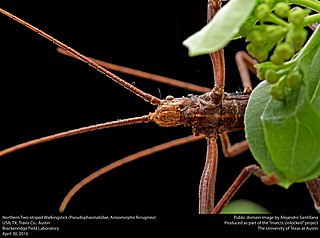 W
WAnisomorpha ferruginea is a species in the family Pseudophasmatidae, in the order Phasmatodea ("walkingsticks"). Common names include "northern two-striped walkingstick", "dark walkingstick", and "prairie alligator". Anisomorpha ferruginea is found in North America.
 W
WBactrododema is a genus of the stick insect family Diapheromeridae. Species of this genus have a relictual distribution and are endemic to southern Africa.
 W
WDiapheromera is a genus of stick insects in the family Diapheromeridae. There are about 14 described species in Diapheromera.
 W
WDiapheromera arizonensis, the Arizona walkingstick, is a species of walkingstick in the family Diapheromeridae. It is found in North America.
 W
WDiapheromera persimilis, the similar walkingstick, is a species of walkingstick in the family Diapheromeridae. It is found in North America.
 W
WDiapheromera velii, the prairie walkingstick, is a species of walkingstick in the family Diapheromeridae. It is found in North America.
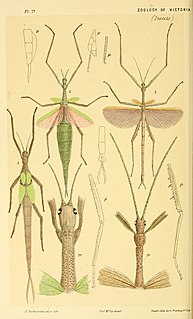 W
WDidymuria violescens, the spur legged phasmid, also known as the violet-winged stick insect, or violet-winged phasma, is a common phasmid native to Australia.
 W
WEurycantha horrida, the thorny devil walking stick, is a species belonging to the stick insects and to the family Phasmatidae.
 W
WHeteronemiidae is a family of walkingsticks in the order Phasmatodea. There are about 14 genera and at least 80 described species in Heteronemiidae.
 W
WLeptynia attenuata is a species of stick insect from Diapheromeridae family which is endemic to Portugal.
 W
WMegaphasma is a genus of walking sticks in the family Diapheromeridae. There are at least two described species in Megaphasma.
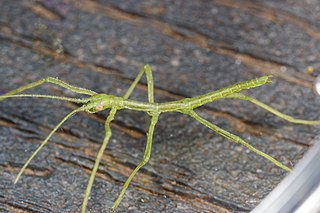 W
WMegaphasma denticrus, the giant walkingstick, is a species of walkingstick in the family Diapheromeridae. It is found in North America.
 W
WOnchestus rentzi is an Australian species of stick insect, commonly named the crowned stick insect, described in 2006. It lives in rainforests along the coast of Queensland and the Northern Territory. It is named after the Australian orthopterist David Rentz.
 W
WPalophinae is a subfamily of the stick insect family Diapheromeridae. They belong to the superfamily Anareolatae of suborder Verophasmatodea.
 W
WParabacillus is a genus of short-horn walkingsticks in the family Heteronemiidae. There are at least three described species in Parabacillus.
 W
WParabacillus hesperus, the western short-horn walkingstick, is a species of walkingstick in the family Heteronemiidae. It is found in North America. This species is found in dry, arid in the summer and fall. Their diet consists of various scrub and grassland plants. Through an adaptation called "crypsis," it blends in so perfectly with its natural habitat that it often goes completely undetected by would-be predators.
 W
WPeruphasma schultei is a species of stick insect found in the Cordillera del Condor region of northern Peru. In the wild the insect feeds on Schinus plants, but will feed on privet, Aucuba japonica and honeysuckle in captivity. In Peru they are only known to exist in a region of less than 5 hectares, but since their discovery they have become increasingly popular as pets worldwide due to their unusual colouration and they are now bred regularly in captivity.
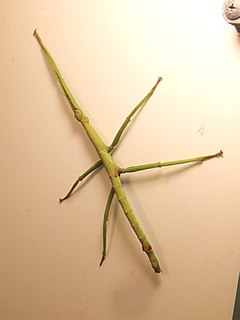 W
WPharnaciini is a tribe of notably large stick insects.
 W
WPhobaeticus serratipes is a species of stick insect that at one time was the longest known insect, with one female specimen recorded as being 555 mm long. This measurement includes the legs fully extended front and rear, and the actual length of the body alone is considerably shorter. This insect is endemic to Peninsular Malaysia, Singapore and Sumatra. It is a popular species among those who raise stick insects.
 W
WPrisopus is a genus of stick insects belonging to the family Prisopodidae. These stick insects are present in America, India and Malesia.
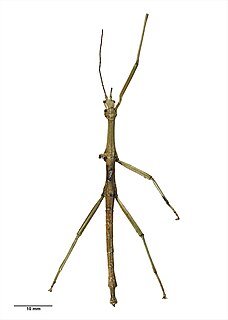 W
WPseudoclitarchus sentus is the sole representative of the genus Pseudoclitarchus, and is a stick insect endemic to the Three Kings Islands. It lives mainly on kanuka trees.
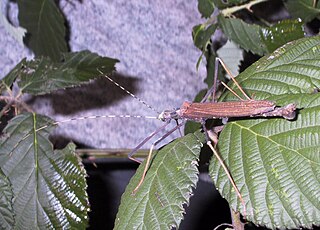 W
WPseudophasmatidae is a family of stick insect, in the suborder Verophasmatodea, commonly called the "striped walkingsticks". An important identifying characteristic is its mesothorax, which is never more than three times as long as the prothorax.
 W
WPseudosermyle is a genus of walkingsticks in the family Diapheromeridae. There are more than 20 described species in Pseudosermyle.
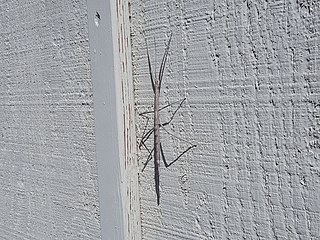 W
WPseudosermyle catalinae, the Catalina walkingstick, is a species of walkingstick in the family Diapheromeridae. It is found in North America.
 W
WPseudosermyle strigata, the striped walkingstick, is a species of walkingstick in the family Diapheromeridae. It is found in North America.
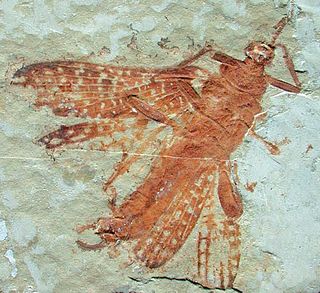 W
WRenphasma is an extinct genus of stick insect which existed in what is now China during the early Cretaceous period. It was named by André Nel and Emmanuel Delfosse in 2011, and the type species is Renphasma sinica, found in the early Aptian aged Yixian Formation. The generic name refers to Dr. Ren Dong, while the specific name refers to Sinica, the Latin name for China.
 W
WTimema bartmani, or Bartman's timema, is a species of stick insect in the family Timematidae. It is found in North America.
 W
WTimema californicum, the California timema, is a species of walkingstick in the family Timematidae. It is found in North America.
 W
WTimema chumash, the chumash timema, is a species of walkingstick in the family Timematidae. It is found in North America.
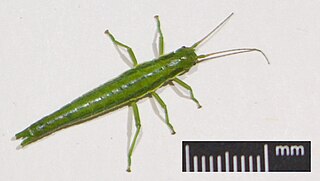 W
WTimema douglasi is a stick insect native to northern California and southern Oregon. It was first identified in 1996 as a specialist feeder on old-growth Douglas fir. It is one of five parthenogenetic species of Timema.
 W
WTimema genevievae, or Genevieve's timema, is a species of walkingstick in the family Timematidae. It is found in North America.
 W
WTimema knulli, Knull's Timema, is a stick insect native to California.
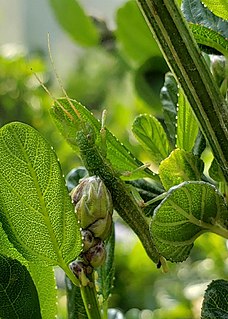 W
WTimema monikense is a parthenogenetic stick insect native to California.
 W
WTimema poppense, the "Pope Valley timema", is a species of walkingstick in the family Timematidae. It is found in California, and originally described from a nature reserve in the Pope Valley.
 W
WTimema shepardi, Shepard's Timema, is a stick insect native to northern California. It was first identified in 1999. It is one of five parthenogenetic species of Timema.
 W
WTropidoderus childrenii, the Children's stick insect, was first described in 1833 by Gray.